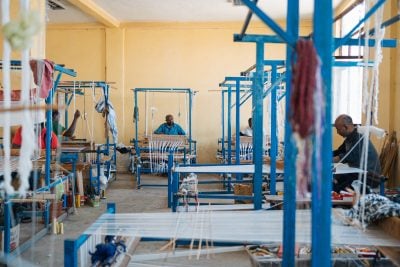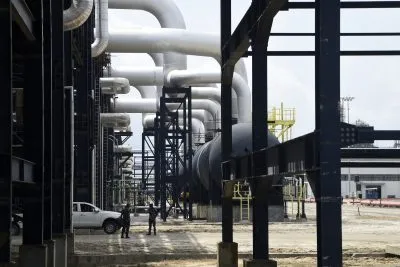The global demand and supply shocks triggered by the outbreak of Covid-19 plunged the world into a major economic recession. In a marked growth reversal from pre-pandemic forecasts, global growth contracted by 3.5% in 2020. Africa suffered its first recession in 25 years amid contracting global demand and trade and a sharp fall in commodity prices and tourism revenue.
These sharp swings reflect, in part, the impact of “policy-induced recessions” over the past 12 months. Containment measures (social distancing, lockdowns, and border closures) adopted by governments to stem the spread of Covid-19 froze the wheels of commerce.
At the height of the pandemic’s first peak in April 2020, month-to-month global trade in goods contracted by 12.1%. The Afreximbank African Commodity Index lost 44% of its value (quarter-on-quarter) in Q1 2020. The sharp tightening of financial conditions triggered massive capital outflows and hampered countries’ ability to finance rising health expenditures. Heightened uncertainty affected investment and FDI flows to Africa. Sharp declines in tourism revenues and remittances further exacerbated liquidity constraints.
Although borrowing costs remain above those from the immediate aftermath of the 2008 financial crisis, spreads have narrowed and capital inflows into Africa have resumed since June 2020. After Egypt, which successfully closed a record $5bn eurobond issuance from global investors in Q2, Côte d’Ivoire raised more than $1bn in late Q4. Both were oversubscribed, affirming the shift in sentiment and international investors’ increasing confidence in Africa’s growth prospects.
Solidifying a soft recovery
While the pandemic may be far from over – casualties are still mounting in much of the world – the soft recovery that began late in Q2 may be a harbinger of strong growth prospects. Consensus forecasts point to a synchronised global recovery, with the global economy projected to grow by 5.5% in 2021.
Across Africa, aggregate output will expand by around 4.5%, boosted by a synchronised bounceback and resilience in a few large economies, with Egypt being one case in point. In a remarkable sign of resilience, Egypt’s economy grew by more than 3.5% in 2020 and is forecast to expand by just as much this year. Kenya, which has been somewhat less tormented by the pandemic, is also set to enjoy a strong recovery this year, with output expanding by more than 6%.
The recovery reflects a combination of factors, including the release of pent-up demand as the pandemic is brought under control and advances are made in Covid-19 treatments, as well as a strong recovery in Africa’s main trading partners.
In the short term, the relaxation of containment measures following improved management of the pandemic will increase mobility and domestic consumption. In the medium term, progress on Covid-19 treatments and vaccinations will moderate the risk aversion behaviour that has reduced individual mobility to hasten the recovery, especially in highly tourism-dependent economies.
Investment expenditures had been rising pre-pandemic across Africa and were the leading growth driver in 2019, accounting for more than 54% of aggregate GDP growth. The African Continental Free Trade Area Area (AfCFTA), which became operational early this year, will accelerate this trend. This will help drive industrialisation and boost intra-African trade flows.
The AfCFTA will shift the composition and direction of investment as corporations capitalise on increasing efficiency and economies of scale to spread the risk of investing in smaller markets across Africa and ultimately wean the region off excessive dependency on primary commodities, which have been the source of excess growth volatility and recurrent balance of payment crises.
Cross-border coordination crucial
Any signs of recovery also reflect the effectiveness of coordinated policy responses undertaken by governments and development finance institutions. Through their countercyclical liquidity support, these institutions (including the African Development Bank and the African Export-Import Bank) are softening the impact of adverse shocks and helping countries deal with acute pressures on liquidity to sustain the growth of trade.
Bold monetary and fiscal responses are other major catalysts for recovery. At around $12 trillion and rising, the scale of discretionary fiscal support has been unprecedented. The new US administration under President Biden is expected to deliver more fiscal stimulus, which should produce spillover growth effects beyond the US. Central bank interventions have been no less astounding.
The US Federal Reserve granted foreign currency swap lines to as many as 14 central banks from advanced and emerging economies. Concurrently, these central banks have reaffirmed their commitment to accommodative monetary policy throughout 2021.
These unprecedented measures ensured that the liquidity crisis caused by global demand shocks have not morphed into solvency crises or a cascade of bankruptcies. But the nature of this crisis is also shaping the growth dividends of these supportive measures. Instead of falling into financial black holes, as happened in 2008, enormous monetary and fiscal stimulus programmes are helping avert avoidable bankruptcies, curtailing insolvencies and boosting global demand and trade.
This is sowing the seeds for a healthier and synchronised global economic recovery as fiscal and monetary support from these leading economies trickles down to emerging ones through trade or investment channels.
Africa’s commitment to macroeconomic stability has helped foster the right conditions for governments in most countries to support the recovery process. Decreasing inflationary pressures in a growing number of nations have enabled central banks to ease monetary policy and adopt other supportive measures to sustain the growth of small and medium-sized enterprises, helping them avert payment defaults. Several monetary authorities have cut policy rates to lower borrowing costs and/or relaxed prudential requirements to free up bank capital with a view to facilitating credit availability for a speedy recovery.
A strong, synchronised global expansion and boost in global demand for commodities will be other major drivers of Africa’s predicted post-pandemic recovery in a region where growth has remained highly correlated with commodity price cycles. Goldman Sachs has forecast a structural bull market for 2021 on the back of strengthening demand spurred by fiscal and monetary stimuluses from major central banks.
The speed at which Covid-19 spread around the world was a reminder of the risks associated with the deepening process of globalisation. The upside, however, is equally important to mention: a global recovery and rising demand for commodities from Africa’s top trading partners – especially the European Union (EU), US, China and India. Over the last two decades, China has been the rising tide lifting all African commodity-exporting boats. Together, China, the EU, US, and India are the destination of more than 55% of African exports and will be major growth accelerators during the forecast recovery.
Dire downside risks
The Covid-19 crisis has been deep and broad-based, with devastating health and economic consequences. The forecast recovery is likely to be uneven. The stickiness of self-imposed risk aversion behaviour is such that the pandemic’s adverse effects on consumer-facing industries could continue to undermine growth in tourism-dependent economies long after the lifting of virus containment measures. Furthermore, the level of projected GDP remains below the pre-virus trend, and considerable uncertainty remains.
Across Africa, risks are tilted to the downside. Those include weaker-than-expected recovery among Africa’s key trading partners; abrupt tightening of financing conditions; a premature return to fiscal consolidation; climate change and extreme weather events that cause food prices to spike; and longer-lasting Covid-19 infection rates.
A feebler pandemic recovery or protracted recession could destabilise the transition back to fiscal and debt sustainability and increase the risk of debt overhang as fiscal revenues remain below pre-pandemic levels for longer than expected. In the absence of additional support from governments constrained by shrinking fiscal space, short-term liquidity crises could morph suddenly into solvency crises and threaten global financial stability.
The design and nature of support provided by the international community to the most vulnerable countries amplify this risk. For instance, the G20’s Debt Service Suspension Initiative (DSSI) was recently extended and is now set to end in June 2021. But without the participation of private creditors the impact of the DSSI was already limited.
Moreover, a protracted recession will further undermine the macroeconomic management and development impact of the DSSI by, for instance, weakening governments’ ability to support the recovery in the short term and advance implementation of the AfCFTA in the medium term. Policymakers could face the difficult trade-off between servicing external debt to official creditors and dealing with the fallout from Covid-19.
Servicing external debt and increasing public investment in infrastructure to crowd-in the private capital needed to lift the supply-side constraints and boost intra-African trade during the AfCFTA’s implementation will become even more important and urgent.
The issuance by the International Monetary Fund of additional Special Drawing Rights (SDRs) to inject liquidity into the global economy and ease balance of payment pressures has been called the most cost-effective and low-risk global response to the pandemic downturn.
Besides preventing liquidity crises from morphing into solvency crises, deploying additional SDRs will bolster investor confidence and strengthen Africa’s economic recovery. It will benefit low-income DSSI-eligible African countries as well as those larger nations, like Nigeria and Kenya, that opted out of the initiative to preserve access to international capital markets, and will play a key role in the region’s recovery.
The daunting risks facing Africa and the rest of the world makes the issuance of additional SDRs even more urgent. Beyond boosting an incipient economic recovery, they will advance the AfCFTA’s implementation and bolster investment in infrastructure, including climate-resilient energy infrastructure and broadband to help Africa leverage digital technologies to boost productivity growth and participate proactively in the reconfiguration of global supply chains post-Covid-19.
The issuance of new SDRs was touted as an important part to the global recovery puzzle in the immediate aftermath of the pandemic downturn, but it is not the only piece – a robust and synchronised global recovery needed to return to pre-pandemic GDP levels will remain elusive in the absence of a strong and well-coordinated international response.
Dr Hippolyte Fofack is chief economist at the African Export-Import Bank (Afreximbank).
Want to continue reading? Subscribe today.
You've read all your free articles for this month! Subscribe now to enjoy full access to our content.
Digital Monthly
£8.00 / month
Receive full unlimited access to our articles, opinions, podcasts and more.
Digital Yearly
£70.00 / year
Our best value offer - save £26 and gain access to all of our digital content for an entire year!
 Sign in with Google
Sign in with Google 



